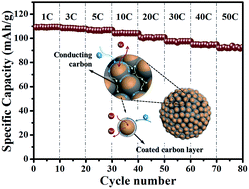Construction of 3D pomegranate-like Na3V2(PO4)3/conducting carbon composites for high-power sodium-ion batteries†
Abstract
Even though Na3V2(PO4)3 (NVP) is regarded as one of the next-generation cathode materials in sodium-ion batteries (SIBs), its undesirable rate performance due to its inherently low electrical conductivity has limited its application in demanding fields such as electric vehicles. Motivated by this fact, the present study profitably employed a conductive carbon grown in situ to obtain an NVP@C composite with a pomegranate-like structure by a simple sol–gel assisted hydrothermal technique. The as-prepared NVP@C composite consists of small carbon-coated NVP particles (∼200 nm) embedded in a conductive carbon matrix, which ensures short ion diffusion distances, percolating electron/ion conduction pathways and stable structural integrity. As a result, the pomegranate-structured NVP@C composite displayed remarkable overall electrochemical performance: a high discharge capacity (110 mA h g−1 at 1C), excellent rate capability (92 mA h g−1 even at 50C) and impressive cycling stability (capacity retention of 91.3% over 2000 cycles at 10C). Such a feasible and beneficial design provides a good strategy for other materials that require both size reduction and high electronic/ionic conductivity.



 Please wait while we load your content...
Please wait while we load your content...